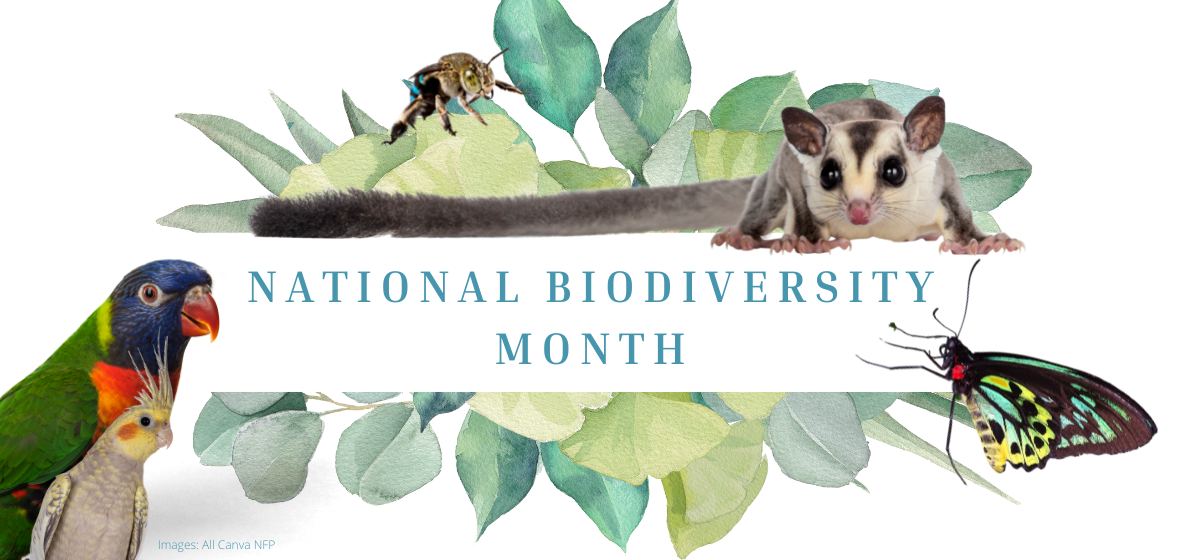
Updated 31 August 2023
Author: Jasmine Greene
September is Biodiversity Month — a month to appreciate the extraordinary web of life we are part of and to encourage the protection, conservation and growth of biodiversity within Australia and worldwide. It also serves as a reminder to reduce the impact we have on the environment to ensure our biodiversity is preserved, both for our species themselves and so that future generations can appreciate them.
Conserving biodiversity: a plight for government, a concern for Australia
Biodiversity encompasses every living thing in existence on our planet and the ecosystems they comprise. The world’s ecosystems face numerous threats, most of which humanity is a catalyst for. But, like all species, humans depend on biodiversity. Essential food and water, and many medicines, minerals and industrial products, are sourced from natural environments, without which we could not survive. Tourism and recreational sectors are also reliant on ecosystem and species diversity.
Australia’s geographic isolation and high percentage of endemic species, many with an evolutionary lineage stretching to Gondwanan times, makes us one of the most biodiverse countries on Earth and one of just seventeen that is recognised as ‘megadiverse’. However, our rate of species endangerment and extinction, habitat loss and subsequent biodiversity loss has intensified since European settlement 235 years ago.
Despite being home to more than 600,000 species (of which four out of five are found nowhere else), over 100 native species have gone extinct and a further 1000+ species are at risk of extinction — of those, at least one-third are critically endangered.
Threats to biodiversity

Left: Northern hairy-nosed wombat (Image: Tim Bawden). Right: Eastern bristlebird (Image: Jenny Donald).
Ecosystems degraded or lost over the past 200 years include 75% of rainforests, nearly 90% of temperate woodlands, and more than 60% of coastal wetlands in southern and eastern Australia.
Queensland, in particular, is gifted with some of this continent’s most awe-inspiring natural wonders which remain under threat. The most renowned is the Great Barrier Reef, but other vulnerable biodiversity hotspots include the Scenic Rim, where subtropical rainforests, mountainous headlands and rocky outcrops support critically endangered or endangered species like the:
- regent honeyeater (Anthochaera phrygia)
- black-tailed antechinus (Antechinus arktos)
- eastern bristlebird (Dasyornis brachypterus).
Parts of the Great Dividing Range, such as Epping Forest National Park, home to a wild population of the critically endangered northern hairy-nosed wombat (Lasiorhinus kreffti), also support endemic species that risk being lost within our lifetime if we do not work to conserve them.
Acting to stop biodiversity loss
The Environmental Protection and Biodiversity Conservation Act 1999 aims to promote biodiversity conservation in Australia by providing protection for threatened species and ecological communities, migratory, marine and other protected species. However, the Act itself is undermined by attempts to remove Federal oversight of development, mining and agricultural plans that may adversely affect threatened species.
Failure to act in time will result in more species extinction. Strategies must therefore be implemented, emerging methods of environmental conservation utilised, and, crucially, adequate funding allocated if Australia is to prioritise and protect its biodiversity.
How you can help protect biodiversity
In the spirit of Biodiversity Month, we urge Australians to get involved in conservation efforts.
You can protect and promote biodiversity in your local community by:
- Transforming your backyard into a wildlife sanctuary. Planting flora native to your region creates habitat for native birds, invertebrates, rodents and reptiles.
- Installing a nest box to help protect wildlife in your area.
- Getting involved in ‘bioblitzes’ like the quarterly Wildlife Queensland Fraser Coast branch bioblitzes. Even the smallest acts of searching for species in your backyard can lead to a passion for wildlife.
- Uploading sightings of any species you see to iNaturalist and the Atlas of Living Australia.
- Reducing your carbon footprint by reducing your plastic use, recycling and properly disposing of rubbish, composing organic items and protecting waterways by never pouring oil or chemicals down the drain.
- Being a responsible pet owner. Much as we love them, pets, particularly cats, can decimate our ecosystems and wildlife. Ensure your pet is registered, desexed and contained, especially at night.
- Getting your hands dirty! Head outside and dig up harmful invasive weeds spreading from your fence or within your neighbourhood.
- Volunteering with your local Wildlife Queensland branch to spend a day revegetating native flora that encourages insect and faunal diversity.
- Signing up to become a member of the Queensland Glider Network, PlatypusWatch, Quoll Seeker’s Network, Richmond Birdwing Conservation Network, and Brush-tailed Rock-wallaby Conservation Network.
We all have a role to play in conserving Australia’s biodiversity, and, if we care to look carefully, biodiversity is all around us.
